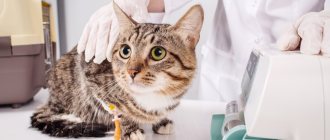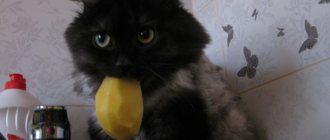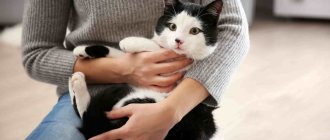Features of the solution
The drug contains chloride, which maintains the acid-base balance and takes part in the synthesis of hydrochloric acid, which stimulates the processing of proteins. Sodium regulates fluid levels and metabolism.
Sodium chloride with glucose 5% in medicine belongs to the group of isotonic solutions, because its pressure corresponds to the osmotic pressure of blood plasma. Salt is a component of plasma and other fluids in the body. The drug removes toxins and does not irritate tissues. It is a colorless transparent solution with a salty aftertaste. Packaged in glass bottles of different capacities, from 100 to 500 ml.
Unforeseen circumstances or what to do if something goes wrong
The most common reason for panic is that a cat is lethargic, sleepy, and boring after an IV drip. Ideally, this shouldn’t happen, but don’t panic – this is normal. If you have never been given a drip, it is difficult to understand, but during the infusion process and for several hours after, the animal experiences internal pressure, similar to languor after a long, hot, hard day, and drowsiness in this state is predictable. Lack of appetite cannot be called normal; the main thing is that the cat drinks (milk, broth, water with glucose).
The cat vomits during or after an IV. Depending on what you vomit, if it’s food you recently ate, don’t panic. Bile, green mucus or foam - observed in liver dysfunction and kidney failure - see a doctor!
The cat's face is swollen after an IV - bad! The first sign of an allergic reaction, as a result of intolerance to the active ingredients of the drug. We run to the nearest pharmacy and buy an antihistamine - Kolem. If there is no time for a consultation or breathing difficulties are noticeable (Quincke’s edema), we administer Prednisolone at the rate of 15 mg per 4–5 kg of weight of an adult animal.
Important! If Calcium Chloride is administered incorrectly, necrosis will begin on the affected soft tissues; the condition is acute, but can be stopped with timely help.
Teaching a dog to fetch a stick in 3 simple steps
Chinese cat Li Hua: Crouching Tiger, Hidden Dragon
General anesthesia: preparation, risks, cat behavior after anesthesia
Causes and symptoms of salt deficiency
The daily requirement for cats and kittens is at least 0.3% chloride and 0.2% sodium. In many foods this percentage is even exceeded. If pets eat industrial food regularly, then they should not have a deficiency of chlorine and sodium. However, during prolonged diarrhea or vomiting, animals' bodies lose large amounts of minerals, which can be hazardous to health.
A lack of sodium chloride makes your cat's blood thicker because some of the water is lost and absorbed by the tissues. A significant lack of fluid causes muscle spasms, convulsions, and disruption of the nervous system and blood circulation in the animal. The animal quickly loses weight and suffers from increased gas formation in the intestines. Kittens experience growth retardation and weakness.
In these cases, the cat must be shown to a veterinarian. The specialist will tell you how and how to treat the disease.
Stages and signs of dehydration
There are three forms of dehydration, each of which is characterized by a specific set of symptoms.
We invite you to read: Why Bengal cats do not like to sit on your hands
Table 1. Gradual development of dehydration in cats
| Form | Signs |
| Mild (hydration deficiency in the body less than 5%) | This stage is difficult to notice as there are almost no symptoms. You can suspect a problem by a slight decrease in the animal’s activity, as well as by its nose - when the cat is healthy and awake, it should be damp and cool. If the nose becomes dry and warm (which is only normal for a sleeping cat), it is possible that the pet does not have enough water. |
| Average (deficiency ranges from 5 to 10%) | Its distinctive feature is that the oral mucosa dries out and becomes pale, and the saliva becomes sticky and viscous. |
| Severe (water shortage increases to 10% or higher) | New signs are added to the signs of the mild and medium stages. The cat becomes weaker, has difficulty moving, sleeps a lot, eats poorly or refuses food altogether. Her heart rate increases, shortness of breath is noticeable. The animal prefers to lie in the dark, away from noise and bright light |
Only a veterinarian can save a cat in the final stages of dehydration.
On a note! When dehydration rapidly progresses and reaches 15-20%, the cat may die within 24 hours. To save the animal, urgent veterinary care will be required, which is only possible in an animal clinic.
Indications for use
Saline solution is freely sold in pharmacies and is most often used intravenously. The veterinarian selects the dosage depending on the cat’s weight.
The drug is prescribed for:
- dehydration due to diarrhea, vomiting, or burns;
- loss of large amounts of fluid as a result of severe bleeding;
- recovery after surgery;
- intoxication;
- state of shock;
- inflammation.
If there is a lack of sodium chloride in the body, the veterinarian will prescribe an injection solution.
Preventing dehydration
It is easier and simpler to prevent any pathology with preventive measures than to treat and eliminate its consequences. This also applies to dehydration in cats. To prevent your beloved pet from suffering from water deficiency:
- She should be fed only food that her body can best digest. Ideally, this is ready-made food from the store;
- you cannot offer the animal food from your table, as well as foods that can cause allergies;
- the owner must ensure that the cat has free access to a bowl with plenty of cool and fresh water;
- the animal must be vaccinated in accordance with its age and habitat, and also undergo periodic examinations by a veterinarian;
- Pathologies identified in a cat should be treated, strictly following all the doctor’s instructions.
How and what to feed kittens and cats correctly (industrial food)
Attention! The owner must monitor how much the cat drinks per day, as well as control the amount of urine in the tray and the frequency of bowel movements. If the animal does not defecate daily, and the feces are hard and dense, there may be a water deficiency. It is important to monitor the cat’s behavior, as well as its appetite.
Terms of use
It is better to give subcutaneous infusions to a cat using drip systems, this will be more convenient for the owner and the pet itself.
A Sodium Chloride dropper for a cat should be placed according to all the rules:
- the solution is used warm and administered slowly;
- It is unacceptable for air to enter the cat’s vein;
- the kitten must be supervised to avoid consequences.
The main stages of setting up an IV:
- First you need to properly prime the infusion system.
- The cat is placed on its side on a flat, soft surface.
- The catheter is unbandaged and washed with a solution of hepatrin and sodium chloride.
- The catheter cap is unscrewed and the drip system cannula is attached to it.
- Open the clamp, adjust the rate of introduction of the solution (20 drops per minute)
- The drugs are injected into the IV with a syringe and a needle through an elastic band.
- After completing the process, the clamp is closed, the cannula is disconnected, and the cap is screwed on.
- Having opened the top valve, the catheter is washed and rolled up.
It will take approximately 2 hours to administer 100 ml of saline solution.
Sodium Chloride is administered subcutaneously to the cat 1-2 times a day using a 0.6 ml syringe or whatever is more suitable for the cat. The solution is injected quickly in one stream.
When administered correctly during treatment, no side effects occur.
The benefits of Sodium Chloride for cats are significant; recovery occurs within a few days.
Why learn to give an injection to a cat?
Learning how to give cat injections yourself will save you money.
The course may involve daily injections. If there are several medications, they may have to be given several times a day. There are several options for how to give your cat the help it needs:
- leave her in the clinic until the end of the course of treatment;
- use the services of a visiting nurse;
- take your cat to the clinic for injections;
- learn how to give injections without resorting to expensive help.
In the first case, you will have to pay a lot of money for treatment, feeding and hospitalization of the cat. In addition, separation from home and her beloved owner will be very stressful for her.
For these cases, the intravenous or intramedullary route is used. The skin is then peeled off the animal's body, creating a "tent". A sterile needle is placed at the base of the tent and fluids are injected. A new needle is used for each treatment. Needles should not be reused under any circumstances as they become dull and dirty. Only sterile, non-antigenic liquid can be injected under the skin. Examples of suitable fluids include lactate solution, normazole, plasmalit or saline solution.
Sugar causes a terrible reaction that often causes abscess formation and peeling of the skin. Sugar placed in a warm subcutaneous space creates an ideal incubator for bacteria. These animals are in severe pain. Even with extensive skin grafts and hospital care, some of these animals died. Here are some examples of fluids that should never be used for subcutaneous fluids. Please talk to your veterinarian before giving any medications or therapy to your pet!
The services of a nurse will cost less than a hospital, and the cat will be at home, which is easier. But this is still an unexpected waste of money.
Daily trips to the veterinary clinic are traumatic for the animal and burdensome for the owner. And it is impossible to take a cat to the hospital several times a day if injections must be given repeatedly.
Kristen Nelson grew up on a farm in Watertown, Minnesota, where she developed a deep love for animals of all kinds. She received her Doctor of Veterinary Medicine degree from the University of Minnesota, College of Veterinary Medicine. Chris then completed a small animal internship at the prestigious Animal Medical Center in New York City. In addition to writing and speaking, she cares for small and exotic animals in Scottsdale, Az. Nelson is widely quoted in the media. Nelson has written two books: Covered in Fur: The Life of a Veteran and Covered in Fur: The Love of a Blind Cat.
By learning how to give injections, you can avoid unnecessary expenses and save yourself and your cat’s nerves. Moreover, it is not difficult if you know how to give the injection correctly.
Sodium chloride for cats – how to use the drug correctly?
Saline solution or sodium chloride for cats is indicated for various pathological conditions, and sometimes the drug is prescribed to cats for preventive purposes. A similar element is found in many products and cat food. The salty liquid can be used to clean your pet’s nose, use it to treat dehydration with frequent diarrhea or vomiting, and cope with shock and other disorders. Although saline solution has few limitations and rarely causes negative reactions, it is still recommended to consult a veterinarian before cleaning your cat's nose with it or using the solution in any other way.
Treatment
First of all, the cause of dehydration should be identified and eliminated. For example, exclude allergenic foods from the diet and make sure that your pet always has fresh water available. When a cat is very ill, you should urgently take it to the clinic.
At home
The main goal of dehydration therapy is to quickly replenish water deficiency. To do this, first place the animal in a cool room and place a bowl of water next to it. If the animal refuses to drink regular water, you can offer it jelly from your favorite canned cat food. In cases where this does not help, it is recommended to force-drink the animal using a small syringe (without a needle!). This must be done carefully so as not to scratch the oral mucosa and not to get water into the cat’s respiratory tract.
Components and mechanism of action
The main component of the drug is chloride, through which the acid-base balance is maintained in the pet’s body. The active substance also participates in the synthesis of hydrochloric acid, due to which the processing of proteins is normalized. Another component of the saline solution is sodium, which is responsible for the amount of fluid and is able to stabilize the cat’s metabolism. In veterinary medicine, a combination of saline solution and 5% glucose is often used, since thanks to this mixture it is possible to remove toxins and not damage tissues. The solution is colorless and slightly salty in taste. You can purchase bottles of 100-500 ml at a veterinary pharmacy. If your pet needs emergency first aid and there is no saline solution on hand, you can prepare it yourself at home. To do this, mix salt with water.
Methods for administering fluids to your pet
There are the following methods of administering fluid using a dropper (or system):
- subcutaneously;
- intravenously.
For one-time instillation of drugs, systems are placed directly into a vein, and for regular instillation, through a catheter. Let's look at each method of administering liquids.
Subcutaneously
An injection into the subcutaneous tissue is considered the most painless compared to the others, but this does not mean that the cat will not resist the intervention. Before the procedure begins, the animal is placed on its stomach so that the withers are as free as possible. In the space between the shoulder blades and the base of the neck, the fur is pinched together with the skin and pulled up. The needle is inserted into the triangle formed in front of the fingers. For convenience, the pinch is made not across, but along the cat, so that there is more free space for inserting the needle. In this case, the syringe must be located at an angle of 90 or 45 degrees to the surface of the skin. To ensure this requirement, an empty syringe is sometimes placed under the IV needle, which lifts the tube at the desired angle.
In the case of a one-time injection, the procedure can be carried out in the groin fold. The dropper is connected only to a needle placed at the withers.
When performing subcutaneous injections, swelling forms at the injection site; this is a normal reaction of the body to the procedure; there is no need to stop the infusion.
To treat my cat, I gave him subcutaneous injections. The cat reacted rather restlessly, but due to the fact that subcutaneous injections can be administered quickly, he tolerated the procedure in the most dignified manner. The injection was performed at the withers, because the cat was lying down and even with all my desire, I would not have been able to gain access to the inguinal fold. I didn’t find anything difficult in the process other than mental anguish. However, a dropper still differs from a simple injection.
My friends had a cat who was sterilized quite late in life, and she suffered from complications. For treatment, doctors prescribed a drip, the drug was administered subcutaneously. The procedure was carried out in the clinic, but in the presence of the animal owner. Doctors installed the system in the treatment room, and then left the owner alone with the animal to wait for the medication to be administered. When inserting a dropper subcutaneously into the withers, the needle can be secured with a band-aid, however, due to the wool, it is not held securely, so the owner must hold the tube with his hand. Fortunately, my friend’s cat had a calm temperament and did not fidget in her hands, plus a sick animal is by default more lethargic and pliable in response to the will of the owner. Closer to the middle of the drip, the cat, as a rule, fell asleep, but periodically still tried to roll over and had to be calmed down.
To administer the fluid subcutaneously, the skin at the withers is pulled back and an injection is made into the resulting triangle.
Intravenously
When administering intravenous fluids, the drip is placed directly or into a catheter.
A one-time intravenous injection in veterinary clinics is performed using a syringe.
Introduction via catheter
A catheter is a medical instrument, a tube with a needle at the end, inserted into the channels and cavities of the body and providing constant access to the bloodstream. It has central and top ports (valves). The central one is used for long-term administration of drugs, and the upper port may be needed to add a drug during the process of administering a drip or administering a heparin solution to prevent the formation of a blood clot.
The color of the top port cap allows catheters to be differentiated by size
A catheter is placed in an animal only by a veterinarian. Installation of a catheter at home is carried out only in exceptional cases due to the complexity of the procedure and the risk of infection. The maximum period for which the tool is installed is 5 days. Thanks to this, administering fluid through a catheter is less traumatic compared to injections into a vein. After all, if this tool is installed, there is no need to constantly subject your pet to painful procedures (injections). The animal will be able to move around with the catheter in its paw, although the instrument may cause minor inconvenience to your pet. Throughout the entire period that the catheter is in the vein, you need to take care of the installation site, not allowing the cat to remove the fixing patch, and also check the paw for swelling and leakage, increased temperature at the installation site and other abnormal symptoms.
Caring for an installed catheter:
- daily checking for contamination and removing it;
- cleaning the external parts of the catheter with alcohol during the day;
- it is necessary to work with the catheter only with clean hands;
- change the catheter fixing patch without using scissors;
- Disinfect or replace the middle port plug (cover) after each use.
Introduction directly
Installation of a dropper directly without the use of a catheter is carried out when a veterinarian prescribes a one-time infusion or to provide emergency care to an animal. The procedure requires competent preparation in the form of an initial consultation with a veterinarian, and then independent study of video materials. Installing a dropper directly, in the same way as in the case of a catheter, allows you to introduce another drug during instillation without removing the system.
A dropper without a catheter is placed if it is necessary to provide emergency assistance to an animal or for a one-time infusion
In what cases is it used?
It is possible to inject saline into a pet subcutaneously, and also give intravenous injections. The instructions for use indicate that sodium chloride can be dropped into the cat's nose, thus performing rinsing. If a kitten or adult feline lacks sodium chloride, the veterinarian will prescribe a drip with saline. Indications for use of the drug are the following pathological conditions in a pet:
- dehydration associated with prolonged diarrhea, vomiting or burns;
- a sharp decrease in the amount of fluid in the cat’s body due to severe bleeding;
- rehabilitation period after surgery;
- signs of intoxication;
- state of shock;
- inflammatory reactions in the cat's body.
Return to contents
Lameness after injection
After the injection, the cat may catch it, but this goes away quickly
After the injection, the cat may tuck its paw or limp. This is due to the irritating effect of the drug. It will go away as soon as the injections stop.
It's worse if the cat starts dragging its paw. This suggests that the needle could have entered the nerve plexus. In this case, you need to contact a veterinarian. Usually, treatment is prescribed in the form of a blockade with novocaine, after which everything returns to normal.
Instructions for use
Nasal rinsing, subcutaneous administration and other methods of using saline for a cat require prior approval from a veterinarian. In most cases, it is recommended to administer the product using a drip system. When placing an IV, adhere to the following rules:
- The saline solution should be warm and administered slowly.
- Prevent air from entering the cat's vein, which will cause life-threatening complications.
- When performing the manipulation, the pet is monitored by a veterinarian or owner in order to notice changes in its condition in time and take the necessary measures.
It is better to put an IV in a hospital setting. The manipulation is performed in several stages:
The system through which the drug will flow into the animal’s vein must be connected to the catheter.
- Correctly prime the infusion system.
- The cat is placed on its left or right side, and the surface should be soft, even and comfortable.
- The catheter is unbandaged and rinsed with saline solution.
- Unscrew the cap from the catheter, connecting the drip system.
- Open the clamp and set the injection rate. 20 drops per minute are recommended.
- The medicine is injected into the IV using a syringe with a needle.
- At the end of the manipulation, close the clamp and screw on the cap.
- Open the top valve, flush the catheter and roll it up.
It takes 2 hours to administer 100 ml of saline to a cat.
You can also rinse your cat’s nose with the drug or use it subcutaneously up to 2 times a day. For the procedure you will need a 0.6 mm syringe, and the solution is injected quickly. If the owner does everything correctly, then the pet feels good and no adverse reactions are observed. The pet recovers after a few days.
At the veterinary clinic
Next, you should act according to the situation: if the animal is still suffering, but does not drink, it is better to consult a doctor. He will prescribe medications for:
We invite you to familiarize yourself with the Toyger: features of the cat breed, history, photos, care.
Everything is done as follows:
- 10 “cubes” of Ringer-Locke liquid are taken into a syringe with a volume of 20 ml3, then 2 to 5 ml of two percent glucose and a quarter of a “cube” of ascorbic acid are added.
- The resulting mixture is shaken and checked for temperature - it should be 39 C.
- Gently knead the skin of the animal’s withers with your fingers for 2-3 seconds, then pull it back and insert a needle placed on a syringe with the composition. The injection should not be done vertically (that is, not from top to bottom, towards the spine), but only horizontally, so that the syringe is located along the cat’s body. The medicine is administered gradually, after which the needle is quickly removed, and the puncture site is treated with cotton wool and alcohol.
The syringe is placed along the cat's body and the medicine is administered gradually
Attention! Subcutaneous administration is recommended for moderate dehydration, and in severe cases, drugs are injected into a vein so that the effect occurs faster.
The duration of infusion therapy (intravenous administration of compounds that relieve intoxication and replenish water deficiency) depends on the condition of the animal. In some cases, the drip is placed for a few minutes, in others – for several hours.
Are there any restrictions?
To prevent saline solution from leading to serious complications in a cat, you need to know how and when to use it. Veterinarians strictly prohibit the use of the drug in pets that have excess sodium in their blood. Saline solution is also contraindicated for pets with cerebral or pulmonary edema, which can cause complications or death. It is equally important to strictly follow the dosage prescribed by the specialist. If owners inject the cat with more solution than required, the following consequences are likely:
- overhydration, characterized by an increased volume of water in the blood;
- acidosis;
- decrease in potassium concentration.
Preparing for the injection
The sheath is not as noticeable on a long-haired cat as on a short-haired cat. Practice at the vet's office the first few times so you feel more competent doing it at home. Don't feel bad if you can't bring yourself to do it.
Most veterinarian offices will offer fluids regularly, but the cost will be slightly higher than that, and the cat may be more stressed by frequent trips to the office veterinarian. A prescription from your veterinarian is usually required. Always check the fluid bag for holes and leaks before use. You may find this easier as a job for two people, one to distract the pet, talk and hold the cat tightly, and the other to manage the fluids. If possible, choose an area in your home that has a window where the cat can look and be distracted. If you are a team of two, have one person entertain the cat by tricking the toy in front of them. Try distracting your cat with the smell of tuna on your fingers. Warming the liquids will make the experience more comfortable for the cat. Microwave temperatures vary and may not heat evenly. Or you may find it helpful to confine your cat to a box, carrier, bathtub, or sink, and then place towels around him to make him less likely to squirm and twist the needle. You can also wrap a towel around the cat to confine it. Consult your veterinarian about using a restraint bag. The procedure is faster, but may be more painful for the cat. A 20 gauge needle is smaller and less painful, but the fluid injection is slower. It depends on what your cat will tolerate. Pay attention to each insertion site and alternate sites each time you administer fluids. Using the same insertion point over and over again can cause scar tissue to form and eventually cause difficulty in inserting the needle. Alternatively, you may hit the muscles, in which case the cat will sense it and react and the flow will stop. You have to move the needle a little bit inside to maintain a good flow. Never use a needle more than once. The needles are extremely sharp, so be careful not to stab yourself. Sometimes your cat can tolerate liquids well and just win at other times. Cats seem to pick up our vibrations, so stay calm and if it doesn't go well one day and you don't get the full dose, just do a balance later that day or the next. Over time, you'll feel like a pro and wonder why you bothered so much about it. Ask your veterinarian for the return of used needles and equipment for the safe disposal of medical waste. Seal the lid when the container is full. Label your homemade containers with a biohazard label. a safe place away from children and animals. The error of the bag for the next session becomes an absolute necessity.
- This is done by gently squeezing the bag.
- If there is a hole, the fluids are contaminated.
- Recycle it and start with a new bag.
On the "References" page under the heading "Subcutaneous Fluids" and "Page 3" in the "User Feedback" section.
Before you give the injection, you need to prepare everything you need
Before you give your cat an injection, you need to prepare everything you need.
Syringe selection
The choice depends on the method of administration of the drug, its type and volume.
If we are talking about a subcutaneous injection, and the amount of medicine does not exceed 1 ml, use an insulin syringe. It has a very thin and short needle, which makes the injection itself less painful and reduces the risk of accidentally injuring the animal. An insulin syringe is suitable for a cat weighing from 3 to 5 kg.
It can also be used for intramuscular injections, but if the drug is oil-based, an insulin syringe will not work. It can clog its thin needle because it hardens quickly.
For oil preparations, choose a 2-3 ml syringe.
The needle on it is longer, so you need to control the depth of its insertion.
If you need to inject a larger volume of medicine, move the needle from the smaller one to the larger syringe.
Studying the drug
Before administering the drug to your cat, read the instructions
- on the number of injections per day;
- for dosage;
- duration of the course;
- expiration date of the medicine;
- method of administration.
In order not to confuse anything, make yourself a reminder and place it in a visible place.
There are drugs that are sold in powder form. They must be diluted with a solvent. Any intramuscular injection is a microtrauma. Therefore, you need to choose a solvent that will reduce the pain of the injection.
In most cases, a 0.5% solution of novocaine is used. If your cat becomes intolerant to it, use saline, Ringer's solution, or water for injection.
Some medications need to be shaken before administration. Any drug should have a cat’s body temperature of 37-39 degrees. Do not use medicine from the refrigerator!
The doctor may prescribe several medications for your cat and recommend mixing them in one syringe. Before administration, make sure that the solution has not changed color after mixing and that no sediment has appeared in it. If this happens, refrain from giving the injection and call your veterinarian.
Everything is in place
Before you take the cat and fix it for the injection, you need to prepare everything so that you can handle it with one hand.
Wash your hands thoroughly and open the package with the syringe and needle. Without removing the cap, place it on the syringe. Open the ampoule using a file or the mark on the neck. Draw up the medicine, tap your fingernail on the syringe tube and use the plunger to squeeze out air bubbles and a couple of drops of medicine to check. Place the cap on the needle and place it on the saucer.
If you have a Sphynx cat, also take an alcohol wipe to disinfect the injection site.
For other cats this is not necessary, they have their own natural layer
Recommended analogues
Saline solution has quite a few contraindications, so it can be used by kittens and cats of any age. But if, for some reason, the veterinarian does not recommend using a veterinary drug, then it is replaced with a drug with a similar effect. Since saline solution is used for various purposes, it has many analogues. For example, you can rinse a cat’s nasal passages with Aqualor. If subcutaneous administration of the product is indicated, then you can replace it with a “Xylate” solution or make a saline solution yourself using water and ordinary salt.
How to give an injection
Insert the needle carefully without sudden movements
Each method has its own technique for administering the drug.
Subcutaneous injection
The skin in the area of the shoulder blades should be pinched with your fingers and pulled back. The needle is inserted along the spine at an angle of 45 degrees, being careful not to pierce the skin fold completely. Do not insert the needle sharply. The skin in this area is quite thick and the needle may bend or break. If you feel strong resistance, slow down the needle insertion. As soon as you feel that the needle is moving freely, inject the medicine.
The skin on a cat's knee is thinner. Also, holding the fold with your fingers, insert the needle at an angle of 45 degrees, trying not to hit the muscle.
In case of infection and abscess formation, the place on the withers is more difficult to treat than on the knee.
With this method and a small volume of the drug, the speed of administration of the drug does not matter. If many injections are prescribed, it is better to alternate injection sites.
Intramuscular injection
With each intramuscular injection, change the paw
To determine the correct location for the injection, place your hand under the cat’s thigh and feel the muscle (it rolls under your fingers). The best place is below the hip joint, approximately in the middle of the muscle. Find the bone with your fingers to determine its location and prevent the needle from getting into it.
The syringe should lie in your hand so that it does not need to be intercepted when administering the medicine. With a sharp movement, insert the needle into the muscle no more than 1 cm, at an angle of 45 degrees. The correct direction of the needle is from the back of the paw.
It is also possible to give an intramuscular injection into the brachialis muscle of the front paw. But it is smaller than the femoral one, so it is a little more difficult to inject into it.
During an intramuscular injection, the medicine is administered slowly - 1 ml over 2-3 seconds, 0.5 ml over one. The larger the volume of medication is administered, the slower it should be done.
The muscle should be relaxed during the injection. If your cat is tense, pet her to calm her down.
The needle is removed immediately after administering the medicine. Only after this can the cat be released. The area of the cat's skin where the injection is given must be healthy.
If a long course of treatment is prescribed, change the paw into which you will inject the medicine each time.
Sodium chloride 0.9%
GENERAL INFORMATION
1. Sodium chloride isotonic 0.9% solution (Natrii chloridi isotonica 0.9% solutio).
2. Sodium chloride isotonic 0.9% solution is a medicinal product in the form of an injection solution containing 0.9 g of sodium chloride as an active substance per 100 ml, and water for injection as a solvent.
3. Sodium chloride isotonic 0.9% solution is a clear, colorless liquid.
4. Sodium chloride isotonic 0.9% solution is produced packaged in 100 ml in sterile hermetically sealed glass bottles of appropriate capacity, sealed with rubber stoppers reinforced with aluminum caps. Each package is labeled with the following indication: the name of the manufacturing organization, its address and trademark, the name of the drug, the name and content of the active substance in %, the method of administration, the batch number (including the date of manufacture), the expiration date, the volume of the drug in the bottle, storage conditions , the inscriptions “Sterile”, “For animals”, quality conformity mark, state registration number, designation of the organization’s standard and are accompanied by instructions for use. Store in a dry place, protected from light, at a temperature from 0 oC to 25 oC. Shelf life, subject to storage conditions, is 2 years from the date of manufacture. Sodium chloride isotonic 0.9% solution should not be used after the expiration date.
PHARMACOLOGICAL PROPERTIES
5. Sodium chloride isotonic 0.9% solution is isotonic to animal blood plasma, regulates the acid-base balance of the body. After administration, the drug is quickly absorbed from the injection site and distributed in the organs and tissues of the animal.
6. According to the degree of impact on the body, sodium chloride isotonic 0.9% solution, according to GOST 12.1.007-76, is classified as a low-hazard substance (hazard class 4), and does not irritate tissue.
ORDER OF APPLICATION
7. Sodium chloride isotonic 0.9% solution is used in animals with large losses of body fluid (bleeding, toxic dyspepsia), shock, intoxication, metritis, vaginitis, as well as for dissolving various medications.
8. Sodium chloride isotonic 0.9% solution is used intravenously or subcutaneously in the following doses:
Animal species Dose, ml/animal
Horses 1000 – 2500
Cattle 2000-5000
Small cattle 100-300
Doses and duration of use depend on the weight of the animal and the course of the disease. When administered subcutaneously, the dose of the drug is administered fractionally to different places.
9. In recommended doses, isotonic sodium chloride 0.9% solution does not cause side effects or complications in animals. Use with caution in case of renal and heart failure.
10. The use of isotonic sodium chloride 0.9% solution does not exclude the use of other medications.
11. There are no contraindications to the use of isotonic sodium chloride 0.9% solution.
12. Livestock products during and after the use of isotonic sodium chloride 0.9% solution are used without restrictions.
PRECAUTIONARY MEASURES
13. When working with Sodium chloride isotonic 0.9% solution, you should follow the general rules of personal hygiene and safety precautions provided for when working with medicines.
14. The medicine should be stored out of the reach of children.
Contraindications
If there is an increased concentration of sodium in the blood, swelling of the brain or lungs, the drug is prohibited for use.
We invite you to familiarize yourself with the Belgian bull, a beef breed of cows: maintenance, benefits, where to buy
IMPORTANT! VETERINARIAN CONSULTATION REQUIRED. INFORMATION FOR INFORMATION ONLY. Share with friends Article rating
Subcutaneous injections of a nutrient solution for dehydration
For subcutaneous feeding with saline solution (or better Ringer-Locke solution from a human pharmacy), draw 10 cubes of saline solution into a 20-cc syringe.
There is also a 2% solution of Glucose in saline (also sold in human pharmacies) 2 cubes. If the cat is still dying of hunger, exhausted, then you can add five cubes of Glucose in saline a couple of times, nothing.
Insert an indwelling urethral catheter and clear the bladder of residual urine. Administer the estimated amount of fluid deficit for dehydration during the first two to four hours of treatment. If urine flow does not occur, read furosemide or administer dopamine.
If oliguria or anuria persists, the amount of fluid administered per day will consist of the sum of the measured urine volume, insensible water loss, and additional losses caused by vomiting or diarrhea. Peritoneal dialysis will be required to remove uremic toxins from the body.
The same syringe contains ONE type of vitamins. If it is an enteroinfection or the like, the most important vitamin is to alternate between B12, B6 and ascorbic acid. The dose of vitamins is a quarter of a one-cubic ampoule. If you inject B12 (200 IU per ampoule), then take half an ampoule. If B12 (500 IU per ampoule) - a quarter of an ampoule.
Supportive fluids may initially consist of lactate or Ringer's acetate, but may eventually be reduced in concentration to half strength in the absence of sodium renal impairment. In patients with severe hypotension, intravenous fluids should be administered as previously described.
Common causes of extreme hyperosmolality in the dog and cat are hyperosmolar nonketotic diabetes mellitus, 6 hypernatremia associated with water deprivation in patients with diabetes insipidus, 13 and significant hypernatremia. 14 In hyperosmolar diabetes, dehydration is easily detected by assessing skin turgor; in the latter two conditions, interstitial water is often retained due to the displacement of fluid from the intracellular space, thereby ensuring normal skin turgor. 15 Eventually, however, the subcutaneous water will become depleted.
And it’s good to add cocarboxylase as a fourth component.
I repeat, each injection contains one vitamin.
Having collected all this into a syringe, chat, close the needle tightly with a cap and warm the syringe under running warm water to about 40 o C. Then wipe and replace the needle with a needle from an insulin syringe.
Using three fingers (thumb, index and middle) of your left hand, pull the cat’s skin so that your index finger is between her shoulder blades. A sort of hump-hood is formed with a fold under the index finger. Wipe thoroughly with alcohol. Make sure that there is free space under the skin (as if there is air in it), press slightly on the syringe plunger so that the medicine splashes out just a little.
In each of these conditions, hypovolemia can be life-threatening. A hypotonic disorder is one in which osmolality and sodium levels decrease in parallel. Clinically significant hyponatremia most often occurs due to the inability to excrete maximally dilute urine.
The goal of treating hyponatremia is to correct water osmolality and restore cell volume by increasing the ratio between sodium water and extracellular fluid. Many patients with hypercalcemia are volume depleted. Because renal excretion of sodium and calcium are coupled, forced physiological diuresis using furosemide and isotonic saline will accelerate calciuresis. Careful monitoring of serum electrolyte levels, especially potassium, is necessary to identify and correct possible hypokalemia.
When inserting a needle into this space, be sure to make sure that the tip is UNDER the skin and not IN the skin. Inject the medicine (all 12-18 cubes) in a row - slowly - into this subcutaneous space. It should be EASY to walk, as if in the air. If it doesn’t go, then the needle is in the skin!
A soft swelling will form on the nape of the neck for a short time - this is normal and completely painless for the cat. It will dissolve before our eyes, and the animal will immediately feel a little better.
All patients receiving rapid physiological diuresis should be monitored for signs of intravascular fluid overload. Fluid management routes of dogs and cats. Comparison of commonly used parenteral fluids in dogs and cats.
We suggest you read: Is it possible to make soil for an aquarium yourself?
Assessing the degree of dehydration. Fluid therapy for special circumstances. Intraosseous infusions of fluids and therapeutic agents. Continuing Education Compendium 11. Intraosseous Infusion Safety: Risks of Fat and Bone Marrow Pulmonary Embolism.
Primer of water, electrolyte and acid-base syndromes. Fluid and electrolyte balance in critically ill patients. Treatment of uncontrolled hemorrhagic shock with hypertonic saline and external counterpressure. Fluid therapy in a critically ill patient.
If the cat does not drink for a day or more, it should be injected once every three to four hours until the cat begins to pee profusely. After this, at least three times a day, until she recovers and starts drinking on her own.
ATTENTION! This is not a treatment for the underlying disease, but support for water-salt balance!
I know of cases when people in extreme situations boiled ordinary tap water for a long time with table salt dissolved in it (saline solution - 0.9% NaCl) and glucose from tablets - and saved the life of an animal.
Cardiac patient fluid management. Monitoring a critically ill patient. Fluid therapy for hypotensive shock. Liquid therapy for gastrointestinal, pancreatic and liver disorders. Acid-base and electrolyte values in dogs with acute gastric dilatation.
Extreme hypernatremia in a dog with central diabetes insipidus: a case report. Hypernatremia and adipia in a dog. Hypernatremia in elderly patients is a heterogeneous, painful and iatrogenic entity. Management of severe hyponatremia: fast or slow correction?
Even if a cat cannot eat or is not allowed to eat, she needs subcutaneous injections!
Here's illustrated advice from
Does your furry pet refuse to eat and stop playing altogether? This is a signal that all is not well with him. A cat can catch a cold, get sick, or get injured. Do not try to make a diagnosis yourself; immediately contact a veterinary clinic to see a specialist. What to do if treatment is prescribed in the form of injections?
https://www.youtube.com/watch?v=i0P4p86dgBU
Treatment of hyponatremia: First, do no harm. In veterinary medicine, drug therapy is given in four ways. Oral - through the mouth Intravenous - through an intravenous catheter Intramedullary - within the medullary canal of the bones Subcutaneous - under the skin. Subcutaneous administration means that fluids are injected under the skin using a needle.
pharmachologic effect
The presented product is capable of having a detoxifying and rehydrating effect (restores water balance). Thanks to this procedure, the sodium deficiency in the human body is quickly replenished, which has a beneficial effect on various pathological conditions. A sodium chloride drip (0.9%) is placed intravenously. In this case, the solution has the same osmotic pressure as that of human blood. In this regard, it is able to be eliminated from the body very quickly, only briefly increasing the volume of circulating red blood cells.
It should be especially noted that, in addition to intravenous drip infusion, this remedy is also used externally. In this case, saline solution helps eliminate the development of pathological microflora and remove pus from the wounds. If a “sodium chloride” drip is placed intravenously, then the infusion of this drug increases urination and also replenishes the deficiency of sodium and chlorine in the human body. By the way, such a solution can be used in setting up the system either in its pure form or used in combination with other medications.
Contraindications and possible adverse reactions in animals
Glucose is one of the components of the internal environment of the body, therefore it does not cause allergic reactions and does not require any adaptation. Once in the blood, it is partially transported to the tissues, and its excess, with the participation of the pancreatic hormone insulin, is converted into glycogen and stored as a strategic reserve. The endocrine system strictly controls that the level of glucose in the blood is in balance and does not go beyond normal limits.
If a cat has diabetes, then this process is disrupted, and the glucose solution introduced into the body can lead to a serious pathological condition - hyperglycemia. This means that if you have diabetes, you cannot give glucose injections at home.
It is also contraindicated to inject glucose if there are infectious processes, fungal infections, or pustules on the animal’s skin. In these conditions, there is a danger that the needle will penetrate the infection into the deeper layers of tissue, so it is recommended to refrain from any injections at home and entrust this manipulation to an experienced veterinarian.
You should also remember about complications associated with non-compliance with instructions and incorrect injection technique. These include inflammation at the injection site and needle breakage during the procedure. This usually happens when the cat is not properly restrained. In these life-threatening situations, you need to urgently contact a veterinarian for help.
Is it possible to inject a cat with glucose subcutaneously?
Go to the vet. It will be more reliable.
Glucose solutions of 5% and 40% are produced packaged in 100 ml glass bottles from... Manufacturing organization NPP Agropharm CJSC, Russia, 394087... Relatively inexpensive. Desperate to cure the cat, they went through...
How do you love your cat, though?
You are unlikely to help him at home, at the vet. I need a clinic. You won't cure it with glucose alone. Moreover, it must be dripped subcutaneously and cannot be injected as a stream.











